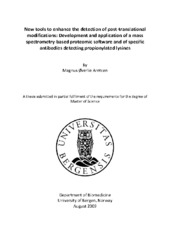New tools to enhance the detection of post-translational modifications: Development and application of a mass spectrometry-based proteomic software and of specific antibodies detecting propionylated lysines
Abstract
Mass spectrometry based proteomics has evolved into a powerful tool in characterising proteins and their respective function in the cell. A proteins cellular localisation, concentration and activity is regulated by several cellular processes including the regulation by protein post-translational modifications (PTMs). PTMs can be viewed as cellular switches that enable or disable specific functions for a protein and they represent a huge potential in understanding protein pathways in the context of protein and protein complex regulation. To date there are over 300 known PTMs which regulate protein structure and function, and their characterisation, as well as the discovery of new PTMs, have immense implications for cell biological and clinical research. However, the detection of PTMs using mass spectrometry is not straightforward. An automatic setup of a mass spectrometer traditionally selects the 2-5 most intense peptides for fragmentation and identification, leaving the rest, less abundant peptides, to pass. Since the majority of post-translationally modified peptides are low abundant and therefore probably not selected for fragmentation and identification, this is a sub-optimal procedure for detecting PTMs. Based on this we wanted to develop bioinformatics software able to increase fragmentation events and identifications of post-translationally modified peptides, using a targeted mass spectrometry approach. This resulted in the development of POSTMan (POST-translational Modification analysis). The underlying principle of this software is to compare two LC-MS runs and search for post-translationally modified peptides as pairs with their unmodified counterparts, either between the two individual LC-MS runs or within one run. POSTMan was designed to be as generic as possible, meaning that in principle any PTM irrespective of mass could be identified with this software. We applied the software to an acetylated model protein of Cytochrome c to verify its capability in identifying the acetylated peptides, as well as the tumour suppressor protein p53 to assess the PTM patterns of acetylation and propionylation. Propionylation was recently discovered as a novel in vivo PTM both on histones and non-histone proteins. The biological role of propionylation however, is currently unknown. Propionylation as an in vivo PTM, as well as its possible involvement in p53 regulation, was addressed using POSTMan and immunoblotting. Novel pan-specific anti-propionyllysine antibodies were raised, characterised and utilized in the study of p53 propionylation. These antibodies showed specificity for propionyllysine with no cross reaction to acetyllysine, and will be important reagents that can be used for global proteomic investigation of propionylation as a regulatory PTM.
Publisher
The University of BergenCopyright
Copyright the author. All rights reservedThe author
